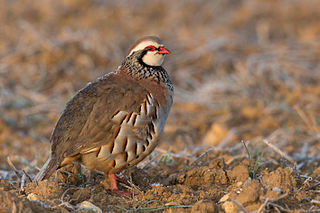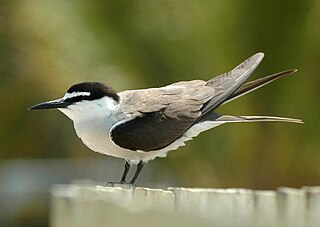
The red-legged partridge is a gamebird in the pheasant family Phasianidae of the order Galliformes, gallinaceous birds. It is sometimes known as French partridge, to distinguish it from the English or grey partridge. The genus name is from Ancient Greek alektoris a farmyard chicken, and rufa is Latin for red or rufous.

The bridled tern is a seabird of the family Laridae. It is a bird of the tropical oceans. The scientific name is from Ancient Greek. The genus comes from onux meaning "claw" or "nail", and prion, meaning "saw". The specific anaethetus means "senseless, stupid".

The northern grey-headed sparrow, also known as the grey-headed sparrow, is a species of bird in the sparrow family Passeridae, which is resident in much of tropical Africa. It occurs in a wide range of open habitats, including open woodlands and human habitation, often occupying the same niche as the house sparrow does in Eurasia.

The South Russian Ovcharka or South Russian Shepherd Dog is breed of flock guardian dog. It developed in the areas of the Russian Empire and the Soviet Union that are now Ukraine and southern Russia, and is thought to derive from cross-breeding between local dogs of the Russian steppes and long-haired shepherd dogs brought to the area from Spain in the late eighteenth century together with Merino sheep. These may have been similar in appearance to the present-day Gos d'Atura Catala.

Apamea crenata, known as the clouded-bordered brindle, is a moth in the family Noctuidae. It is distributed throughout the Palearctic realm. In the North it crosses the Arctic Circle, in the Mediterranean it is found only in cool locations and mountains avoiding very hot areas. In the Alps, it rises to an altitude of about 2000 metres.

Lygephila pastinum, the blackneck, is a moth of the family Erebidae. The species was first described by Georg Friedrich Treitschke in 1826. It is found in Europe and across the Palearctic Siberia, the Russian Far East, Japan and China.

Lacanobia thalassina, the pale-shouldered brocade, is a moth of the family Noctuidae. It is found in Europe east across the Palearctic to the Russian Far East and Siberia.

Pulicaria dysenterica, the common fleabane, or, in North America, meadow false fleabane, is a species of fleabane in the family Asteraceae. It is native to Europe and western Asia where it grows in a variety of habitats ranging from semi-arid Mediterranean woodlands to wetter situations. Pulicaria dysenterica is perennial and can form dense clusters of plants, spreading by its roots. It flowers at its maximum height of about 60 centimetres (2.0 ft). Leaves are alternately arranged and clasp the stem, which itself contains a salty-astringent liquid. The yellow inflorescences are typically composed of a prominent centre of 40–100 disc florets surrounded by 20–30 narrow, pistillate ray florets. When setting seed the flower heads reflex.

Lygephila craccae, the scarce blackneck, is a moth of the family Erebidae. It is found in temperate Europe and across the Palearctic to the Altai Mountains, Korea, Japan and China.

Agrochola litura, the brown-spot pinion, is a moth of the family Noctuidae. The species was first described by Carl Linnaeus in 1761. It is found in Europe and the Middle East. It is possibly also present in North Africa, but this is unclear because similar looking species Agrochola meridionalis is found there.

Apamea zeta is a moth of the family Noctuidae. It has a Holarctic distribution, and can be found throughout the Northern Hemisphere. It occurs throughout Europe and the northern half of North America.

Trichiura crataegi, the pale eggar or pale oak eggar, is a moth of the family Lasiocampidae. It was first described by Carl Linnaeus in his 1758 10th edition of Systema Naturae. It is found in all of Europe, east to Anatolia and east across the Palearctic to Amur.

Nycteola revayana, the oak nycteoline, is a moth of the family Nolidae. The species was first described by Giovanni Antonio Scopoli in 1772. It is found from Europe and east across the Palearctic to Japan and India.
Ptocheuusa paupella, the light fleabane neb, is a moth of the family Gelechiidae. It is found from central and southern Europe to the Ural Mountains. It is also found in Turkey and India.

Ptocheuusa abnormella is a moth of the family Gelechiidae. It is found from central and southern Europe to the Ural Mountains.

Anomologinae is a subfamily of moths in the family Gelechiidae.
Ptocheuusa sublutella is a moth of the family Gelechiidae. It was described by Hugo Theodor Christoph in 1873. It is found in southern European Russia.
Ptocheuusa multistrigella is a moth of the family Gelechiidae. It was described by Émile Louis Ragonot in 1892. It is found in Tunisia.
Ptocheuusa cuprimarginella is a moth of the family Gelechiidae. It was described by Pierre Chrétien in 1915. It is found in Algeria.
Ptocheuusa albiramis is a moth of the family Gelechiidae. It was described by Edward Meyrick in 1923. It is found in Egypt.















